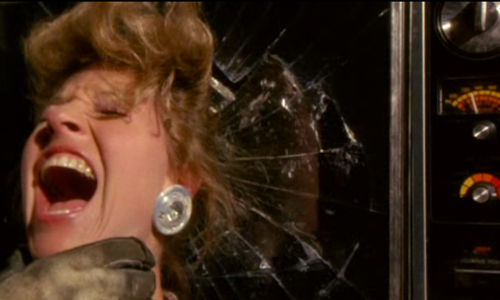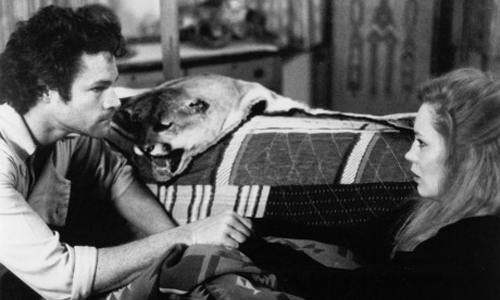Following their collaboration on Performance – arguably the most influential counter-culture film to come out of the UK in the ‘70s – Nic Roeg went on to make 16 feature films, various shorts, and worked in television; Donald Cammell made just three more movies, a couple of shorts and some videos for U2.
Of these three films, Demon Seed was generic, enlivened by Julie Christie’s central performance, but compromised from the outset by the fuck-awfulness of Dean R. Koontz’s source novel; White of the Eye, under consideration here today; and Wild Side, which was so badly fucked around with by the producers that it drove Cammell to suicide.
A talented painter from a bohemian background (his father knew Aleister Crowley), ostensibly Cammell was a natural fit for underground, arthouse and/or counter-culture cinema. But cinema turned out to be his nemesis. And its agent in human form was Marlon Brando.
On various occasions, Brando engaged Cammell to work on projects with him, variously as writer, director or to produce a novelisation. Each time, the mercurial Brando lost interest and walked away, huge chunks of Cammell’s time and effort having gone for nothing. The unmade Jericho is a case in point: Cammell had spent a year and a half in Mexico on pre-production when Brando decided he couldn’t be bothered any more.
It is debatable, had any of these aborted collaborations made it to fruition, as to how much they would have borne the stamp of Brando as opposed to Cammell. They’re morbidly fascinating to ponder on, in the same way that lingering on the great unrealised films of Michael Powell or Sam Peckinpah, or Jodorowsky’s vision for Dune – hell, pretty much any project that any filmmaker of any real stature pursued but didn’t get to make – offers a seductive but ultimately depressing trip down the rabbit hole.
It would be a full decade after Demon Seed that Cammell got to direct another film and thankfully what we see on the screen is entirely his vision. Co-adapting with his wife China Cammell, White of the Eye was based on the Edgar Award-winning novel Mrs White by brothers Andrew and Laurence Klavan, writing under the pseudonym Margaret Tracy.

Relocating the action from Connecticut to Tucson, which Cammell shoots as if it were an alien planet, the story starts with a Grand Guignol set-piece – a murder staged so operatically and elliptically that you’d think you were watching a giallo by Mario Bava or Dario Argento – then segues into the study of a marriage. Specifically that of Paul (David Keith) and Joan White (Cathy Moriarty). Their relationship is sometimes spiky, sometimes passionate. One thing’s for sure: daughter Danielle (Danielle Smith) is the apple of their eye. Paul runs a successful business installing high-end stereo systems for monied clients. He has a penchant for opera and is having an affair with clingy socialite Ann Mason (Alberta Watson). Oh, and Joan is becoming increasingly convinced that he’s a serial killer.
What follows is a fragmented fever dream involving flashbacks to Joan’s road trip with former boyfriend Mike DeSantos (Alan Rosenberg) and Paul’s destructive intervention into their relationship; revelations in the present about Paul’s chequered past; Mike’s reappearance and his claims of prescience; subsequent murders and the efforts of Detective Charles Mendoza (Art Evans) to pin them on Paul.
Cinematographer Larry McConkey and editor Terry Rawlings seem to have tapped directly into Cammell’s psyche, creating landscapes that are also mindscapes, and fractured images and juxtapositions that show those mindscapes crumbling. Narrative is shunted aside – occasional exposition dumps from Detective Mendoza keep the audience in the loop – so that Cammell can get on with the real business of crafting a mood piece; a film-poem written in the bleakest cursive.
David Keith gives the performance of his career, subverting an Everyman persona by degrees until the viewer recoils from a creeping sense of complicity. His all-American looks twist at key moments as if something grotesque were crawling beneath his skin. Cathy Moriarty, always possessed of an otherworldly quality in her screen performances, plays Joan as a sultry enigma shading into a gathering storm. When the revelations – and subsequent conflict – finally occurs, the effect is electrifying.
The pressure-cooker chemistry between the two leads is amplified by a visual aesthetic that walks a film-long tightrope, forever seeming about to tip over into hysteria. The recurring image of a dilating eye is apt: Cammell sears the celluloid (and the viewer’s retina) with images that are gorgeous, hellish and provocative. The murders are exquisitely staged and repulsive in content. The quarry-set finale is Wagnerian.
White of the Eye is stunning, disturbing and compelling. Despite the operatic pitch that informs most of its running time, Cammell conjures grace notes and moments of introspective subtlety, often unexpectedly. For all that, however, it remains a film whose chief concerns are the venality of the human condition, the primal urge to destruction and self-destruction, and the thin surface between ordered calm and la bête humaine. It is also about transience; how everything passes, even the granite majesty of the landscape.
Neil Fulwood

Leave a Reply